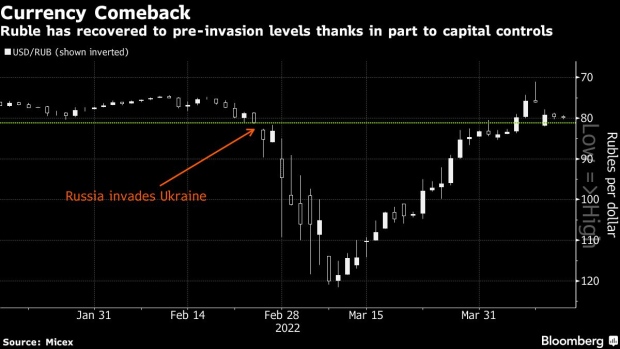Apr 14, 2022
Russia Considers Next Step in Loosening Wartime Capital Controls
, Bloomberg News

(Bloomberg) -- Russian authorities are considering a step-by-step approach to rolling back the harsh capital controls imposed to stabilize markets after the invasion of Ukraine.
Discussions this week focused on options that included extending the deadline for exporters to carry out mandatory conversions of their overseas earnings into rubles and lowering below 80% the share of foreign proceeds that companies are obliged to sell in the market, according to people informed on the matter.
A decision hasn’t yet been made after talks that involved the central bank, they said, asking not to be identified because the deliberations are confidential.
RBC reported that the central bank confirmed it’s weighing an extension to give exporters more than the required three working days to convert foreign currency after it’s been credited to an account.
The Bank of Russia didn’t immediately respond to a Bloomberg request for comment.
In place for over a month, the requirements were among a flurry of emergency measures in response to sanctions enacted after President Vladimir Putin sent his troops into Ukraine. Facing a rapid sell-off in assets and the steepest depreciation in the ruble since 1998, policy makers ordered the sale of hard-currency earnings alongside other steps that included a ban on the sale of securities held by foreigners.
How War and Sanctions Have Sparked Ruble Volatility: QuickTake
Unable to intervene in the market because of the seizure of about half in Russia’s international reserves, the central bank effectively shifted the responsibility for defending the currency to exporters, mainly energy producers such as Rosneft and Gazprom.
But the stringent controls have created a mismatch between the supply and demand for foreign currency, feeding a rally in the ruble that helped it regain all ground lost after the war began. With commodity prices surging, some Russian metal and mining companies are now struggling to sell dollars in such big volumes, according to people familiar with the matter.
Russia is also benefiting from record high commodity prices, meaning it’s raking in billions of dollars in revenues a month from its exports including gas, metals and grains. Bloomberg Economics expects Russia will earn nearly $321 billion from energy exports alone this year, an increase of more than a third from 2021.
Exporters are currently selling $1.4 billion a day, according to ITI Capital, more than the $1 billion that Bank of Russia deployed daily to support the ruble at the beginning of the invasion.
“Russia is getting huge foreign currency inflow but the market can’t digest this volume,” ITI Capital analyst Iskander Lutsko said by phone. “Trade volumes are insignificant, there are no foreign investors, no offshore market, no algotrading, no big players, even local ones.”
Lutsko estimates that exporters could sell 40% of revenues at most.
Before the war, Russia limited the ruble’s dependence on oil prices by buying foreign currency when crude rose above certain levels, and selling when it fell lower.
The central bank has already moved to undo some capital controls, first easing restrictions on transfers abroad and last week announcing it would remove a commission for buying hard currency through brokerages and scrap a ban on the sale of foreign-exchange cash to individuals.
The decisions sent the ruble sharply weaker this week, setting the stage for additional measures as imports collapse and Russia’s current-account surplus surges to a record.
“The likely first step to reduce appreciating pressure on the ruble would be to modify the requirement on exporters to sell 80% of their export proceeds,” said Tatiana Orlova, lead economist at Oxford Economics. “Cutting it to 50% for example would give a right signal.”
©2022 Bloomberg L.P.






